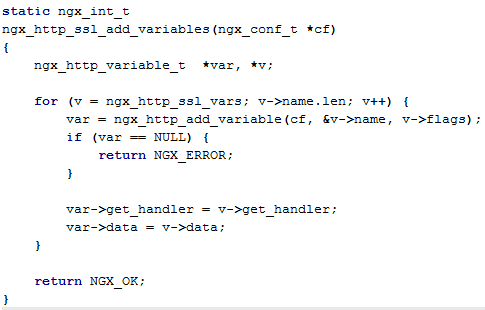Nginx内部变量使用
2015-09-01 13:31
686 查看
Nginx的内部变量指nginx官方模块中所导出的变量,大部分常用的变量都是CORE HTTP模块导出。在nginx中,可以在模块开发代码 中使用变量,也可以在配置文件中使用。
配置文件中使用方法:
在配置文件中使用内部变量,只需要在变量名前加一个”$”符号就可以了,eg,使用http模块的host变量,写成($host)形式。
模块代码中使用方法:
在模块代码中使用内部变量较为麻烦,nginx提供了以下一些接口来取得变量:
其中,前两个函数都是用来取得有索引的变量,区别在于后一个会处理NGX_HTTP_VAR_NOCACHEABLE这个标记。而最后一个函数可以取得没有索引的变量值。
Nginx也提供了获得变量索引的接口:
模块开发中使用的例子:
配置文件中创建:
Nginx的ngx_http_rewrite_module模块提供了set配置指令

我们可以在配置文件中直接使用它:
模块调用中创建:
Nginx中提供下面的接口创建变量:
而变量结构体(ngx_http_variable_s)是以下结构:
其中,name是变量名字,set/get_handler表示对应的设置以及读取回调,data是传递给回调的参数,flags表示变量属性,index是该变量的索引。
其中,flag属性是以下几个属性的组合
变量在nginx中初始化时,首先在解析HTTP之前会调用ngx_http_variables_add_core_vars(pre_config)来将HTTP core模块导出的变量(http_host/remote_addr…)添加进全局的hash key链中,然后调用ngx_http_variables_init_vars来初始化所有的变量(包括其他HTTP模块的变量,以及在配置文件中通过set指令设置的变量),当请求过来时会给每个请求创建一个变量数组,只有取变量值的时候,才会将变量保存在对应的变量数组位置。
模块开发中创建变量的例子(ngx_http_ssl_module.c):

ssl模块中,变量存放在一个ngx_http_variable_t数组中:
配置文件中使用方法:
在配置文件中使用内部变量,只需要在变量名前加一个”$”符号就可以了,eg,使用http模块的host变量,写成($host)形式。
模块代码中使用方法:
在模块代码中使用内部变量较为麻烦,nginx提供了以下一些接口来取得变量:
ngx_http_variable_value_t *ngx_http_get_indexed_variable(ngx_http_request_t *r, ngx_uint_t index); ngx_http_variable_value_t *ngx_http_get_flushed_variable(ngx_http_request_t *r, ngx_uint_t index); ngx_http_variable_value_t *ngx_http_get_variable(ngx_http_request_t *r, ngx_str_t *name, ngx_uint_t key);
其中,前两个函数都是用来取得有索引的变量,区别在于后一个会处理NGX_HTTP_VAR_NOCACHEABLE这个标记。而最后一个函数可以取得没有索引的变量值。
Nginx也提供了获得变量索引的接口:
ngx_int_t ngx_http_get_variable_index(ngx_conf_t *cf, ngx_str_t *name);
模块开发中使用的例子:
static ngx_int_t index_1;
static char * ngx_http_op(ngx_conf_t *cf,ngx_command_t *cmd, void *conf)
{
ngx_http_core_loc_conf_t *clcf;
clcf = ngx_http_conf_get_module_loc_conf(cf,ngx_http_core_module);
clcf->handler = ngx_http_op_handler;
//定义变量名
ngx_str_t name = ngx_string("name of variable");
//得到该变量名的索引值
index_1 = ngx_http_get_variable_index(cf,&name);
return NGX_CONF_OK;
}
static ngx_int_t ngx_http_op_handler(ngx_http_request_t *r)
{
u_char ngx_string[1024]={0}; //存储返回的字符串
ngx_http_variable_value_t *value;
value = ngx_http_get_indexed_variable(r,index);
if (value == NULL || value->not_found){
ngx_sprintf(ngx_string,"value is not exsit!");
}
else {
ngx_sprintf(ngx_string,"value:%s",value->data);
}
}自定义变量创建
在Nginx中,我们也可以自定义创建变量。创建变量有两种方式,分别是在配置文件中使用set指令,以及在模块中调用对应的接口。配置文件中创建:
Nginx的ngx_http_rewrite_module模块提供了set配置指令

我们可以在配置文件中直接使用它:
set $a "hello"; #对变量a进行赋值操作,把字符串hello赋值给a
模块调用中创建:
Nginx中提供下面的接口创建变量:
/* ** 该函数将变量"name"添加进全局hash key表 */ ngx_http_variable_t *ngx_http_add_variable(ngx_conf_t *cf, ngx_str_t *name, ngx_uint_t flags);
而变量结构体(ngx_http_variable_s)是以下结构:
struct ngx_http_variable_s {
ngx_str_t name; /* must be first to build the hash */
ngx_http_set_variable_pt set_handler;
ngx_http_get_variable_pt get_handler;
uintptr_t data;
ngx_ui
4000
nt_t flags;
ngx_uint_t index;
};其中,name是变量名字,set/get_handler表示对应的设置以及读取回调,data是传递给回调的参数,flags表示变量属性,index是该变量的索引。
其中,flag属性是以下几个属性的组合
#define NGX_HTTP_VAR_CHANGEABLE 1 /* 变量可变 */ #define NGX_HTTP_VAR_NOCACHEABLE 2 /* 不直接返回上次cache的值,每次都需要去取值 */ #define NGX_HTTP_VAR_INDEXED 4 /* 变量使用索引读取 */ #define NGX_HTTP_VAR_NOHASH 8 /* 变量不需要被hash */
变量在nginx中初始化时,首先在解析HTTP之前会调用ngx_http_variables_add_core_vars(pre_config)来将HTTP core模块导出的变量(http_host/remote_addr…)添加进全局的hash key链中,然后调用ngx_http_variables_init_vars来初始化所有的变量(包括其他HTTP模块的变量,以及在配置文件中通过set指令设置的变量),当请求过来时会给每个请求创建一个变量数组,只有取变量值的时候,才会将变量保存在对应的变量数组位置。
模块开发中创建变量的例子(ngx_http_ssl_module.c):

ssl模块中,变量存放在一个ngx_http_variable_t数组中:
static ngx_http_variable_t ngx_http_ssl_vars[] = {
{ ngx_string("ssl_protocol"), NULL, ngx_http_ssl_static_variable,
(uintptr_t) ngx_ssl_get_protocol, NGX_HTTP_VAR_CHANGEABLE, 0 },
{ ngx_string("ssl_cipher"), NULL, ngx_http_ssl_static_variable,
(uintptr_t) ngx_ssl_get_cipher_name, NGX_HTTP_VAR_CHANGEABLE, 0 },
{ ngx_string("ssl_session_id"), NULL, ngx_http_ssl_variable,
(uintptr_t) ngx_ssl_get_session_id, NGX_HTTP_VAR_CHANGEABLE, 0 },
{ ngx_string("ssl_session_reused"), NULL, ngx_http_ssl_variable,
(uintptr_t) ngx_ssl_get_session_reused, NGX_HTTP_VAR_CHANGEABLE, 0 },
{ ngx_string("ssl_server_name"), NULL, ngx_http_ssl_variable,
(uintptr_t) ngx_ssl_get_server_name, NGX_HTTP_VAR_CHANGEABLE, 0 },
{ ngx_string("ssl_client_cert"), NULL, ngx_http_ssl_variable,
(uintptr_t) ngx_ssl_get_certificate, NGX_HTTP_VAR_CHANGEABLE, 0 },
{ ngx_string("ssl_client_raw_cert"), NULL, ngx_http_ssl_variable,
(uintptr_t) ngx_ssl_get_raw_certificate,
NGX_HTTP_VAR_CHANGEABLE, 0 },
{ ngx_string("ssl_client_s_dn"), NULL, ngx_http_ssl_variable,
(uintptr_t) ngx_ssl_get_subject_dn, NGX_HTTP_VAR_CHANGEABLE, 0 },
{ ngx_string("ssl_client_i_dn"), NULL, ngx_http_ssl_variable,
(uintptr_t) ngx_ssl_get_issuer_dn, NGX_HTTP_VAR_CHANGEABLE, 0 },
{ ngx_string("ssl_client_serial"), NULL, ngx_http_ssl_variable,
(uintptr_t) ngx_ssl_get_serial_number, NGX_HTTP_VAR_CHANGEABLE, 0 },
{ ngx_string("ssl_client_fingerprint"), NULL, ngx_http_ssl_variable,
(uintptr_t) ngx_ssl_get_fingerprint, NGX_HTTP_VAR_CHANGEABLE, 0 },
{ ngx_string("ssl_client_verify"), NULL, ngx_http_ssl_variable,
(uintptr_t) ngx_ssl_get_client_verify, NGX_HTTP_VAR_CHANGEABLE, 0 },
{ ngx_null_string, NULL, NULL, 0, 0, 0 }
};
相关文章推荐
- Nginx开发从入门到精通
- 提取nginx日志5分钟内的访问状态
- nginx+ajax跨域访问设置
- nginx+jquery+ajax搭建的qaweb游戏测试平台
- nginx 不带www到www域名的重定向
- nginx内置全局变量及含义
- nginx-配置文件详细说明
- Nginx RTMP 流媒体直播
- 在虚拟机中centos版本的linux的nginx安装
- Nginx基础. Nginx基本哈希表
- nginx作为下载文件服务器
- heartbeat做nginx高可用集群
- 一些NGINX配置
- Nginx基础笔记
- 分布式文件存储fastdfs
- 优化Nginx中FastCGI参数的实例
- CentOS 7 + Nginx 1.9.4
- 【转】nginx+iis实现负载均衡
- 测试Nginx对PHP的解析功能--查看PHP安装配置以及功能列表统计信息
- 配置Nginx来支持PHP----重点介绍Nginx如何通过PHP_FPM的FastCGI进程对PHP进行解析处理。
